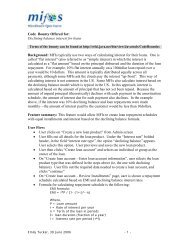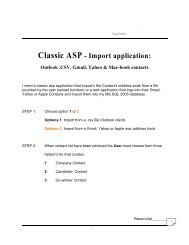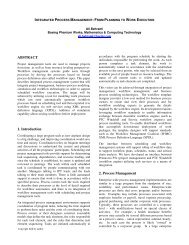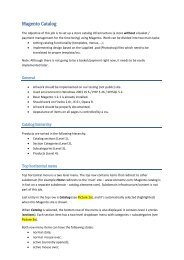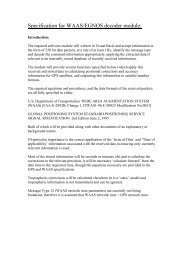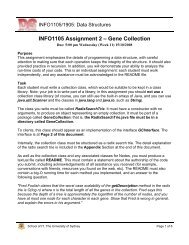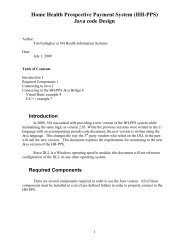Can Lapacho cure the cancer ? - GetACoder
Can Lapacho cure the cancer ? - GetACoder
Can Lapacho cure the cancer ? - GetACoder
You also want an ePaper? Increase the reach of your titles
YUMPU automatically turns print PDFs into web optimized ePapers that Google loves.
<strong>Can</strong> <strong>Lapacho</strong> <strong>cure</strong> <strong>the</strong> <strong>cancer</strong> ?<br />
<strong>Lapacho</strong> (Tabebuia impetiginosa) also known as Pau d’Arco or Taheebo is a canopy tree<br />
growing in <strong>the</strong> Amazonian rainforest and o<strong>the</strong>r parts of South America. This hard-wooded<br />
plant, commonly used for carving and construction is hoped to be a miraculous <strong>cure</strong> for<br />
<strong>cancer</strong>s and tumors.<br />
Tradition...<br />
<strong>Lapacho</strong> inner bark is customary used in local medicine for bacterial and fungus infections,<br />
malaria, fever, syphilis, stomach and bladder conditions, as well as inflammation of <strong>the</strong><br />
prostate gland (prostatitis), dysentery, boils and ulcers, pain and various <strong>cancer</strong>s.<br />
Biomedical uses of <strong>Lapacho</strong> were reported as early as in 1873. First, Pau d’Arco attracted<br />
scientists attention in Brazil and Argentina after <strong>the</strong> news magazine O'Cruzeiro described<br />
cases of wondrous <strong>cure</strong>s in hospitalized <strong>cancer</strong> patients.<br />
…..and science<br />
The scientific interest in <strong>Lapacho</strong> begins in <strong>the</strong> 1960s when United States National <strong>Can</strong>cer<br />
Institute started examining plant extracts originated from different geographical locations to<br />
identify active anti-<strong>cancer</strong> compounds.<br />
Two leading bioactive components have been identified: lapachol and beta-lapahone. Betalapahone<br />
is believed to be <strong>the</strong> main anti-tumor compound. It has demonstrated promising<br />
anti-<strong>cancer</strong> activity during phase I clinical trials and currently is undergoing numerous phase<br />
II human clinical trials for <strong>the</strong> treatment of pancreatic <strong>cancer</strong>, head and neck <strong>cancer</strong>, and<br />
leiomyosarcoma.<br />
How it works?<br />
Scientists from Simmons <strong>Can</strong>cer Centre (USA) have managed to work out <strong>the</strong> mechanism of<br />
action of beta-lapachone.<br />
Beta-lapachone interacts with an enzyme called NQO1. In healthy cells, NQO1 is ei<strong>the</strong>r not<br />
present or is expressed at low levels. In contrast, some <strong>cancer</strong> cells overexpress <strong>the</strong><br />
enzyme. When beta-lapachone interacts with NQO1, <strong>the</strong> tumor cell kills itself without<br />
damaging healthy tissues. Beta-lapachone also disrupts <strong>the</strong> <strong>cancer</strong> cells ability to repair its<br />
DNA leading to <strong>the</strong> cells decease.
Understanding how beta-lapachone works to selectively kill tumor cells creates a new hope<br />
for patients suffering from resistant to chemo<strong>the</strong>rapy <strong>cancer</strong>s.<br />
O<strong>the</strong>r health benefits<br />
Antibacterial activity<br />
Chemical compounds of <strong>the</strong> inner bark of taheebo inhibit <strong>the</strong> growth of harmful to human<br />
germs, as Clostridium paraputrificum – a bacteria of a digestive track that can cause<br />
clostridial infection or Helibacter pyroli infecting <strong>the</strong> lining of <strong>the</strong> stomach and duodenum and<br />
in some cases leading to ulcer.<br />
In vitro studies also revealed anti-bacterial actions of lapacho extract against MRSA.<br />
Antipsoriatic activity<br />
Some lapacho-derived compounds appear to be promising as effective antipsoriatic agents<br />
due to <strong>the</strong>ir activity against <strong>the</strong> growth of human skin cells - keratinocytes.<br />
Anti-ageing<br />
Certain volatiles compounds isolated from <strong>the</strong> dried inner bark of Tabebuia have displayed<br />
antioxidant activity.<br />
Obesity, diabetes and heart disease risk<br />
Scientists have shown using rats as animal models, that extract from lapacho can block<br />
dietary fat absorption, and thus reduce <strong>the</strong> risks of obesity, type 2 diabetes and coronary<br />
heart disease. This fact is associated with lapacho ability of reducing <strong>the</strong> levels of<br />
triglycerides. A food-supplement based on Tabebuia could potentially decrease <strong>the</strong> incidence<br />
of <strong>the</strong>se diseases.<br />
Pau d’Arco is also used for such conditions as: candidiasis, herpes simplex virus, influenza,<br />
schistosomiasis and brucellosis, however <strong>the</strong> healing effects has not been confirmed by<br />
clinical trials yet.<br />
Dosage<br />
Pau d'arco is sold as tablets, dried bark tea and tincture. Tea is not recommended as healing<br />
compounds of lapacho do not dissolve well in water.<br />
Generally, recommended dosage for an adult person is 300-500mg three times per day for<br />
capsules and 0.5- 1 ml (1/8 – 1/4 tablespoon) for tincture.<br />
Remember, always consult <strong>the</strong> dosage with your doctor !<br />
Side effects
Detailed analysis revealed that <strong>Lapacho</strong> is generally safe for humans. In some rare cases it<br />
may cause nausea, vomiting, anemia, bleeding and dizziness. The possibility of side effects<br />
occurring is grater when <strong>the</strong> dose of lapachol overcome 1.5 g a day.<br />
We still don’t have a complete scientific profile of <strong>Lapacho</strong> as potential diet supplement and<br />
fur<strong>the</strong>r clinical research is required. Also - <strong>the</strong> drugs available on <strong>the</strong> market are of various<br />
composition and quality, so it is hard to determine if <strong>the</strong>y contain a safe amount of <strong>the</strong>se<br />
active substances – please always read <strong>the</strong> label.<br />
Drug interactions<br />
Tabebuia may enhance <strong>the</strong> activity of antiplatelet and anticoagulant drugs (blood-thinners)<br />
including Warfarin (Coumadin), Clopidogrel (Plavix) and aspirin.<br />
Children<br />
Children and infants should not be treated with lapacho.<br />
Pregnancy & Breastfeeding:<br />
Due to lack of clinical evidence, consuming of lapacho-based food supplements during<br />
pregnancy and breastfeeding should be avoided.



